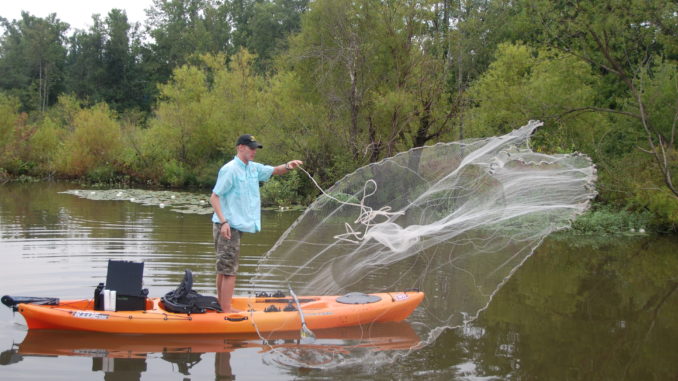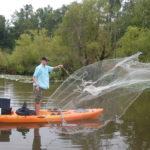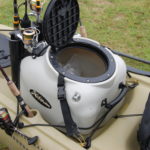
Catching, storing bait can present problems
Regardless of the watercraft under your feet, fall fishing often means chasing fish that require live bait to catch. Powerboat anglers often take for granted the space and other considerations required to operate a bait tank or built-in livewell — a luxury for which most paddlers simply don’t have space or carrying capacity.
Depending on whether you’re fishing freshwater or saltwater and the species of bait you want to use, paddling anglers have several options available to stock up with bait just before and sometimes during their fishing outings.
For many, the prospect of throwing a cast net from a kayak is a daunting task. However, a 6- to 8-foot cast net represents a good investment in terms of weight and space for catching bait, even from a kayak.
Tommy Samuels of Summerville, a pro staffer for Wilderness Systems, frequently promotes that company’s line of stable kayaks, which allow anglers to stand when fishing or even stand and maneuver to throw a cast net. Before those innovations, Samuels developed a simple method of throwing a net while sitting down.
“The biggest difference in my sitting-down method is that after I get my load set up, I loop the lead line through the fingers of my dominant hand,” he said. “By doing this, I can make a simple toss without having to do a lot of twisting and turning, and I can keep my balance better.”
Samuels loads the net by looping the cast-net line and holding it and the horn in his left hand. He then reaches down and loops about a third of the lead line in each of his fingers in order: index, middle, ring and pinky. He then grabs the remaining lead line in his off-hand.
“Always throw strong side to weak side,” he said. “I’m a lefty, so I throw left to right. It’s just a simple toss to open the net. You don’t want a lot of net hanging down, because it makes it harder to throw and will catch on the side of the kayak.”
Samuels then transfers the bait to a soft-sided cooler if he’s going to use cut bait or a trolling bucket that hangs outside the boat for live bait.
Larger baitfish can be caught using conventional rod-and-reel methods. For bull redfish, sharks, or tarpon, Brad Knight of Belton, a Hobie Fishing Team member, takes along a smaller rod that he refers to as a bait rod.
“When I’m fishing in a river or the mouth of an inlet, I might stop a little while on the way out and bottom-fish using some frozen shrimp,” said Knight. “This time of year, there’s plenty of spot, croaker, whiting and ladyfish to be found in the creeks, and all of those make great bait, whole or cut, for larger fish.”
Storing his catch in a small cooler or troll bucket, Knight said he doesn’t worry about getting a whole day’s worth of bait.
“If I’ve got a half-dozen baits, it’s enough to get started,” he said. “I usually anchor up near some kind of structure, and once I’ve put a couple of the bigger rods out, I’ll get the bait rod back out and keep fishing for more bait right under the kayak.”
Mike Eady, a kayak guide in the Grand Strand area, uses a lot of blue crab for bait to catch redfish and bonnethead sharks. Eady said sometimes he’ll go to the bait, and sometimes it comes to him.
“It happens all the time, I’ll be staked out trying to catch a fish and look over, and there’s a big crab just easing along,” said Eady (843-246-0045). “That’s why I carry a dip net, and I can just reach over and scoop him up. Other times, I might put a crab trap out the day before if I know I need crabs for bait, and I have taken chicken necks with me and caught them on a hand line from my kayak.”
Some species, including striped bass inland or king mackerel off the beach, nearly demand the use of live herring or menhaden to be successful. For those instances, a few forward thinking manufacturers have developed bait tanks or livewells specifically for kayaks.
Hobie’s Livewell Bait Tank system takes bait fishing to the next level. The 6-volt, battery-operated livewell recirculates fresh water through a kayak’s scuppers into an 8-gallon tank, keeping the bait lively and healthy. The tank features a twist-and-seal hatch cover to keep the tank watertight and allow easy access. The tank fits in the rear cargo well and straps down securely with nylon straps. Three rod holders come attached to the tank allowing additional space for multiple rods.
“This is the best kayak livewell on the market,” said guide Justin Carter of Charleston-based KayakFishSC (843-725-8784). “The pump is incredible. It really moves a lot of water through the tank and keeps the bait lively. It’s also got great battery life, and because it fits inside the boat, there’s no drag that you get from pulling a bait bucket around beside the boat.”






Be the first to comment